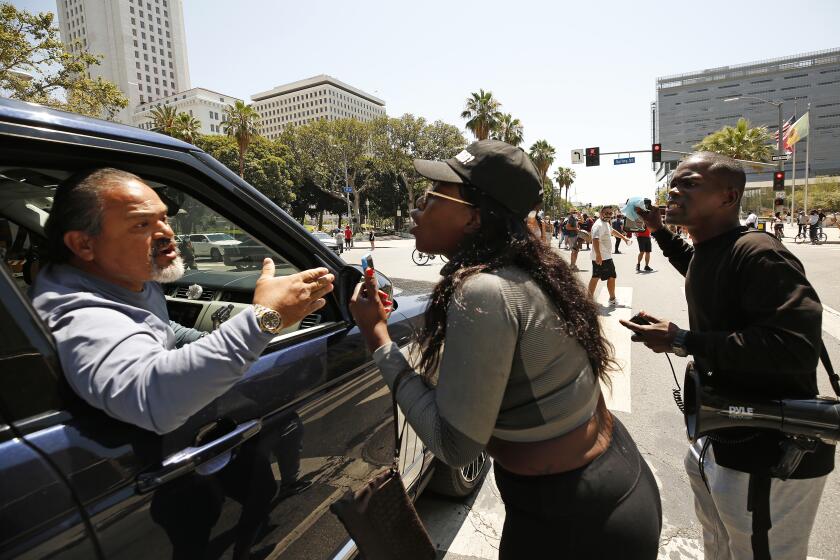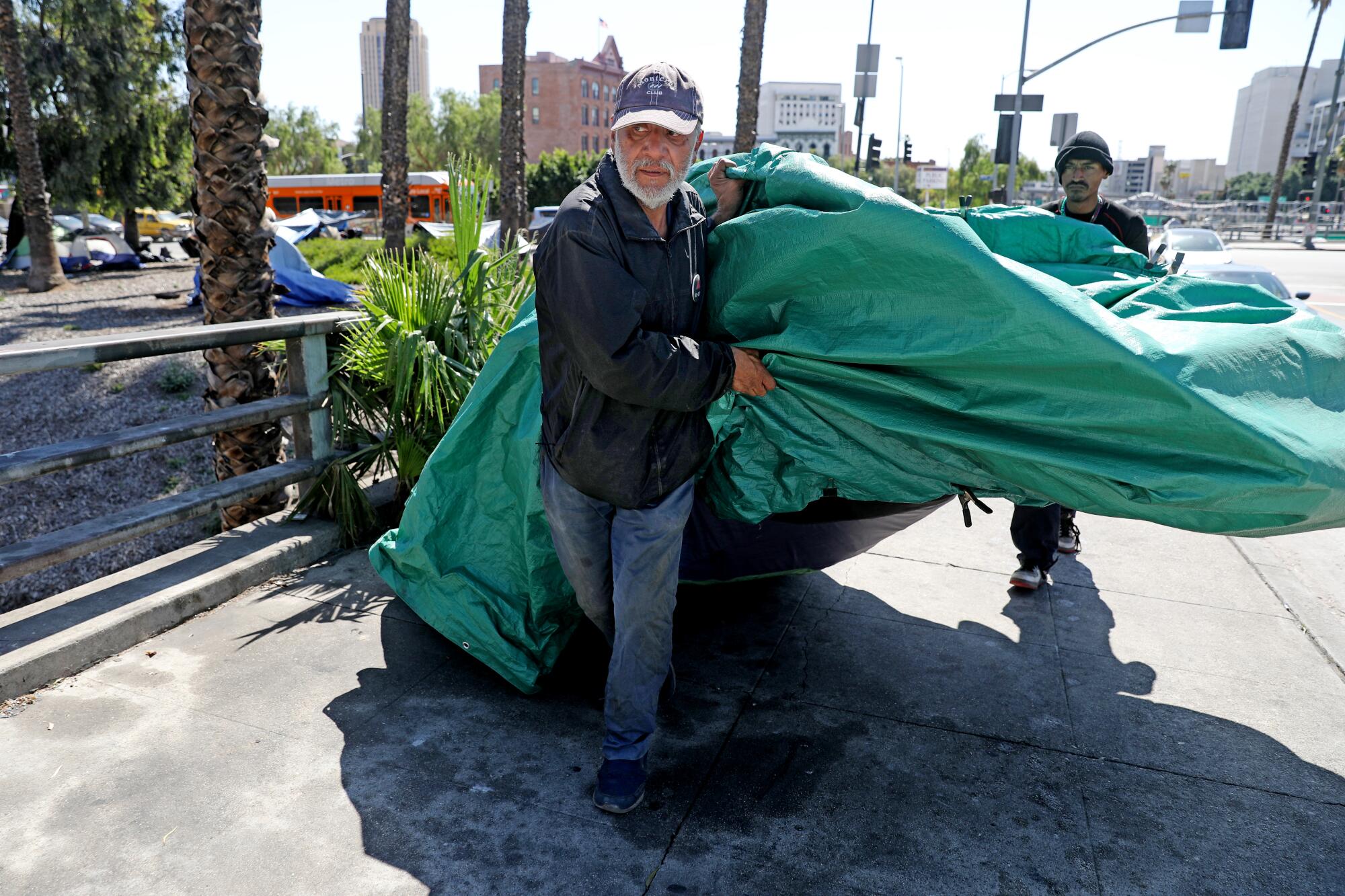
- Share via
The posted deadline for every tent and shanty to be gone arrived on a Monday.
Yet by noon, life continued at its desultory pace as people began to stir in the dozen structures pressed against the guardrail over the 101 Freeway in downtown L.A.
“Tomorrow,” said Harvey Hernandez, 58, a longtime denizen of downtown streets who displayed his awareness of the city’s anti-camping law with a button pinned to his shirt citing the ordinance by its number: “41.18 = Death.”
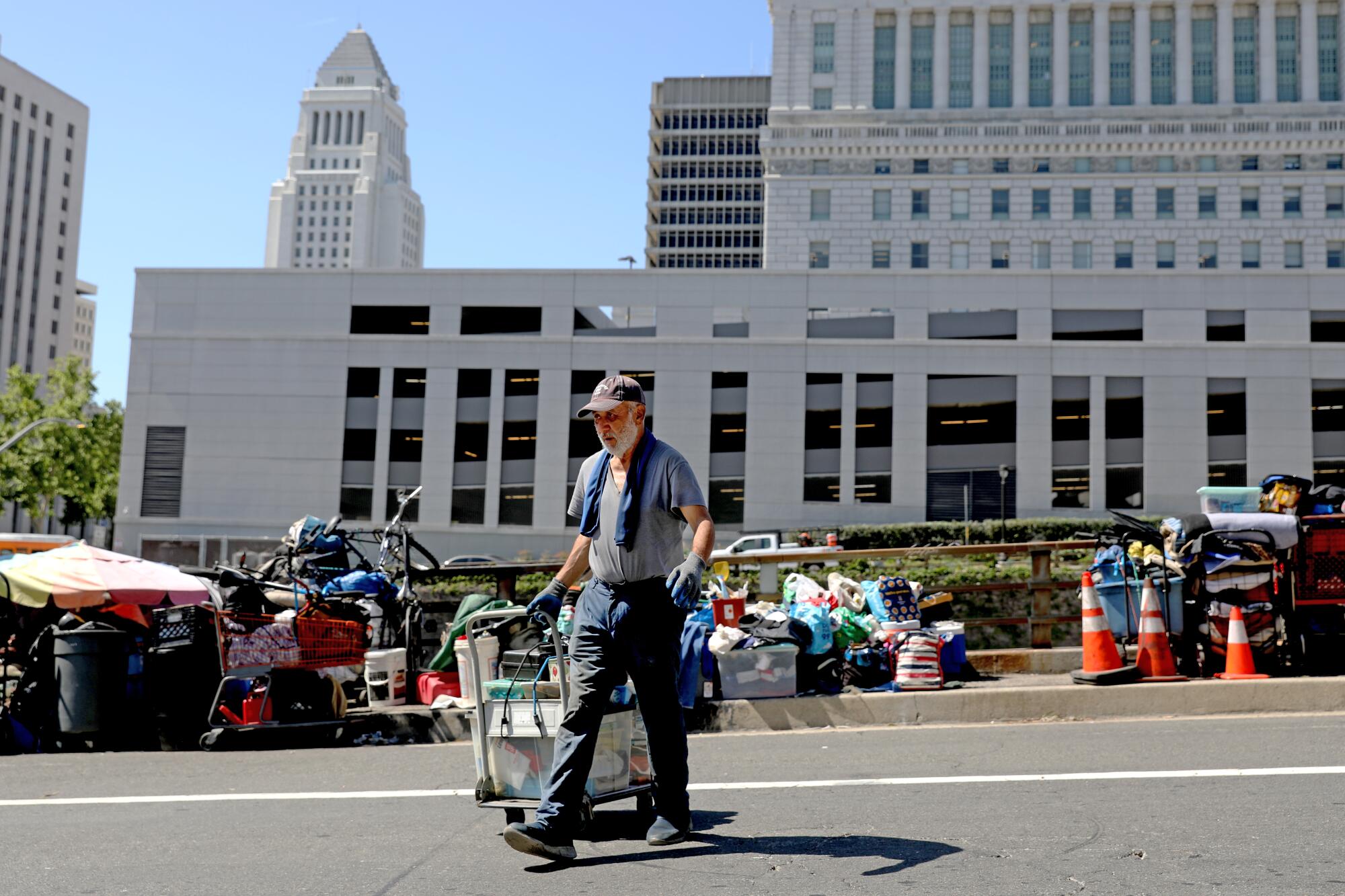
Tuesday is the regular cleaning day when everyone on the north side of Arcadia Street packs up home and belongings and carts them temporarily to the other side of the street. Hernandez figured that’s when the police would move in to make them take an offer of shelter or face the consequences.
“I know we’re going to have to move sooner or later,” he said. But shelter, even a private room in a hotel, was not for him. He’d heard bad stories and wanted no part of it.
“I’ll go over there to the other side of the MTA building,” he said, pointing to the skyscraper that stands alone on the north side of downtown.
Such jaded suspense is becoming the dominant mood in some homeless encampments from the San Fernando Valley to South L.A. as enforcement of Los Angeles’ revised anti-camping law rolls out in slow and uneven steps.
Nine months after the City Council adopted the new law allowing council members to designate areas as off-limits to homeless camps, permanent metal signs setting deadlines for all homeless people to leave have been posted at more than 100 locations. But tents and makeshift shelters remain at many of the sites even weeks or months past the deadlines as outreach workers struggle to persuade people to move voluntarily and the Los Angeles Police Department has issued tickets sparingly.
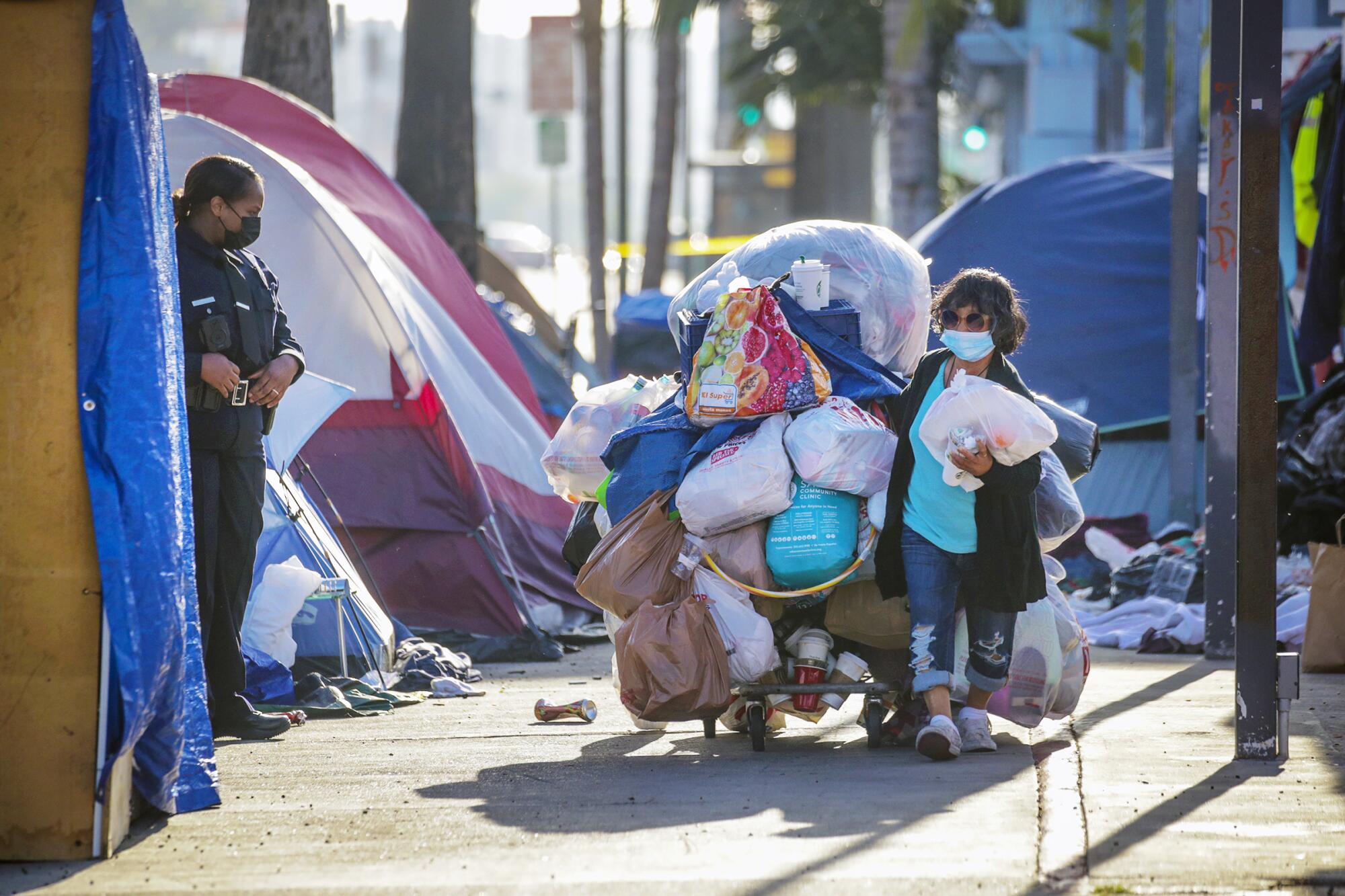
So far this year, city officials have identified only two citations for setting up tents or otherwise being in a no-encampment zone.
An insufficient number of outreach workers and a lack of interim housing options have hindered the implementation of the law, according to homeless services providers, and city and county officials. Simply put, there are not enough shelters, tiny homes or hotel rooms for people on the streets to go to and not enough people to help coordinate getting them there.
The result is that there was little consistency in what a team of Times reporters saw when they visited more than two dozen of the banned sites.
Some locations had more people living on the sidewalk than they did when outreach workers from the Los Angeles Homeless Services Authority initially assessed the spots. Others previously had tents and encampments but are now clear. When asked to account for where people went, LAHSA was in many cases unable to say.
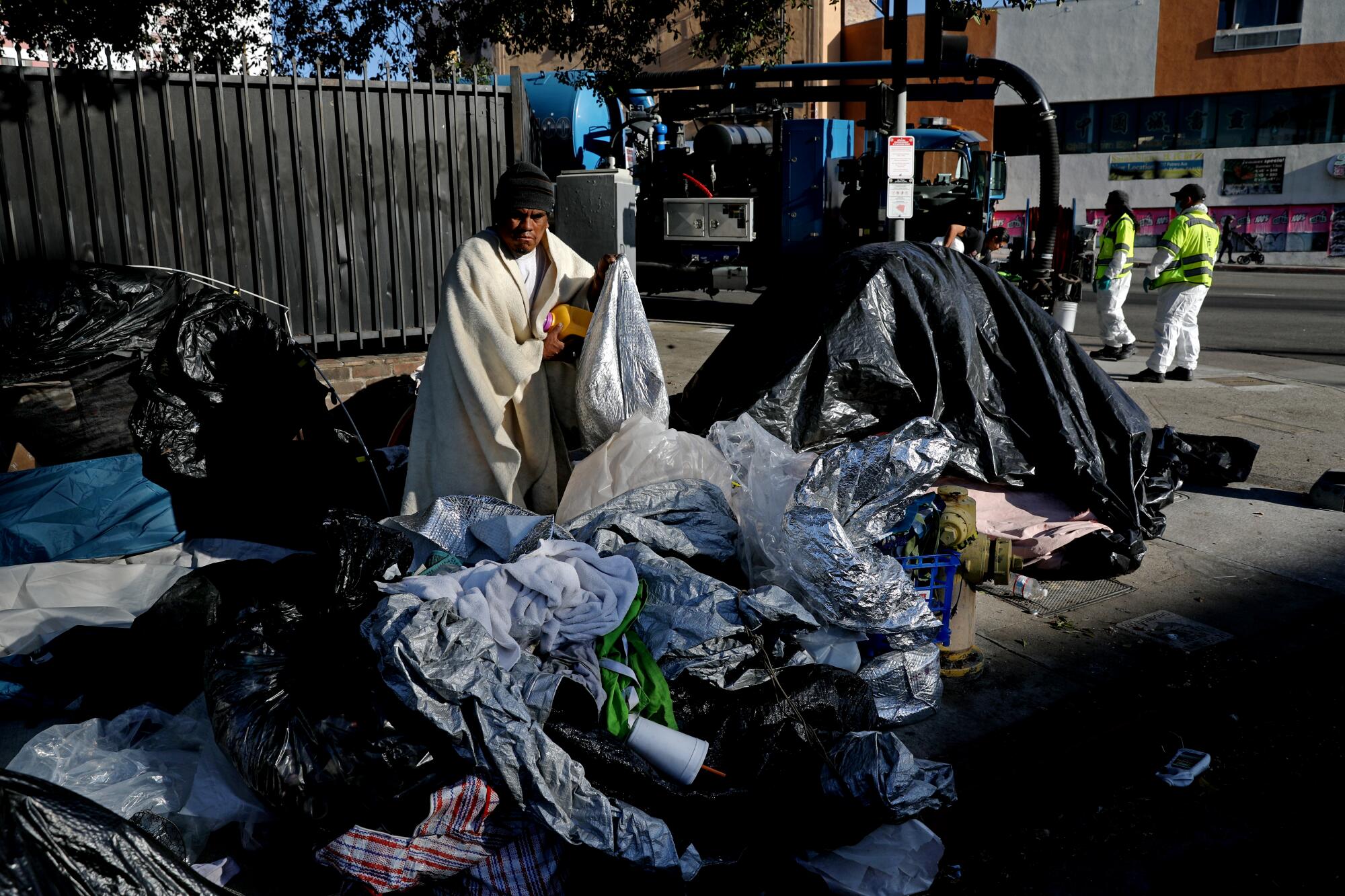
One of the signs, posted in December at an underpass of the 101 Freeway in Silver Lake, prohibits camping there after Jan. 3. Last week, though, about seven tents still blocked the sidewalk along with a mix of personal possessions — chairs, couches, stoves — and trash. Cars that people live in lined the block on North Vendome Street and snaked around the corner partway up a block of Dillon Avenue.

Some locations had more people living on the sidewalk than they did when outreach workers from the Los Angeles Homeless Services Authority initially assessed the spots. Others previously had tents and encampments but are now clear. When asked to account for where people went, LAHSA was in many cases unable to say
Chuy Nunez, 28, came here after his previous encampment was cleared in November. Outreach workers from LAHSA have placed him on lists, he said, but nothing has come of it.
“Where am I supposed to go?” he asked.
Gabriel Dominguez swept the street around the minibus in which he’s lived for a decade. Next to the vehicle, a naked woman sat on the ground with headphones over her ears, moaning and yelling obscenities.
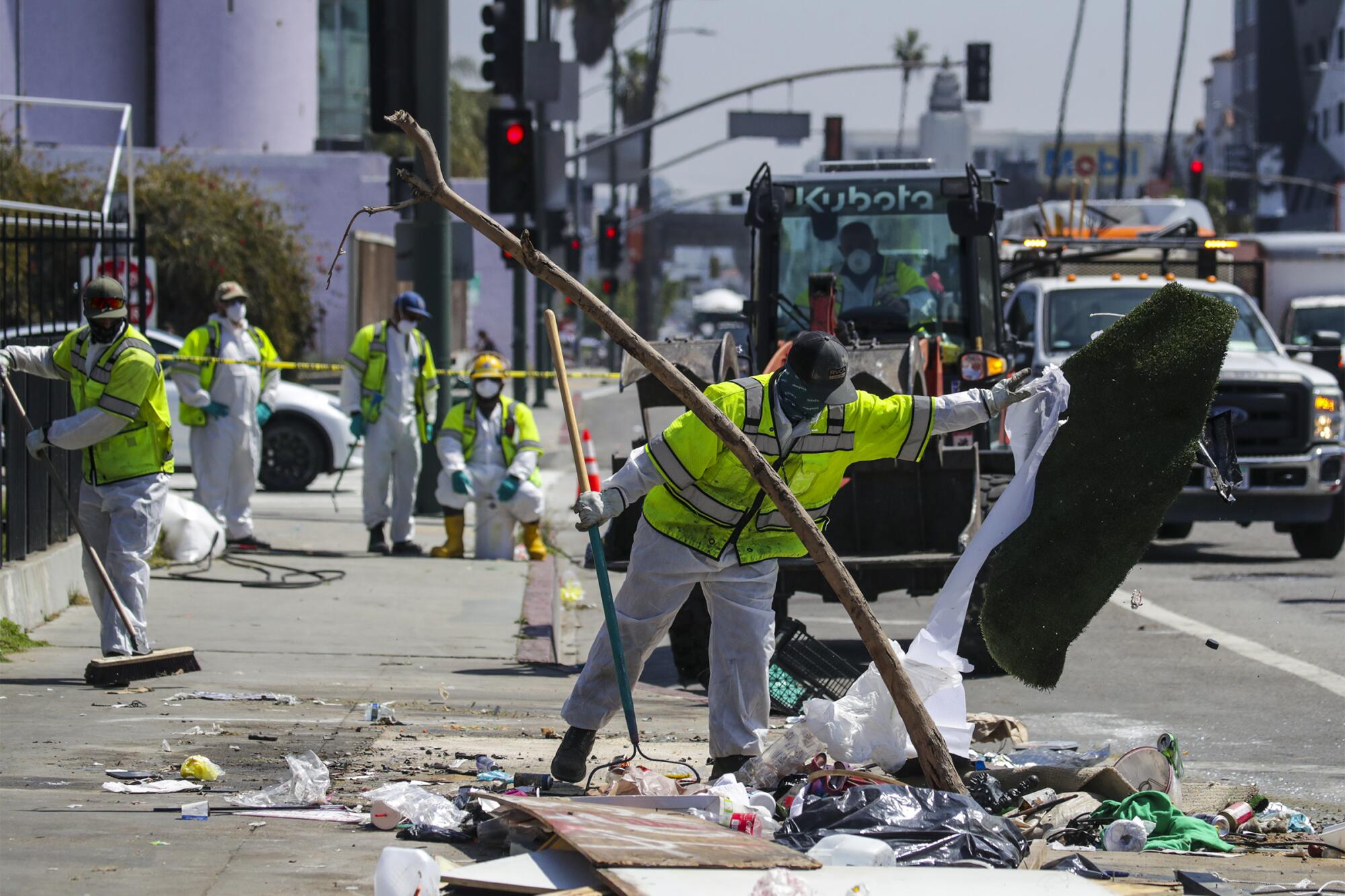
Dominguez said she comes around from time to time and he tries to find her clothing, food and water.
“I care for her like a baby,” he said.
A native of Mexico, Dominguez said he has lived in Los Angeles for 36 years and has worked at a bakery in Culver City for the last two. The night job has made staying in the hotels he’s been offered as shelter not feasible partly because of the curfews. And he likes staying in the neighborhood — where he plays soccer and has close bonds with other people living on the block.
Along with curfews, reasons cited by homeless people for resisting offers of interim housing include rules against visitors and drug and alcohol use, lack of privacy and extended waits for permanent housing that may not arrive.
Dominguez benefited from the relaxation of parking restrictions during the pandemic but now wonders where he and others will go as cleanups in the area become more frequent and enforcement of parking rules becomes more aggressive. Farther north on Dillon, they had watched the city tow an RV and clear out several tents a few weeks earlier.
The law now heads to Mayor Eric Garcetti’s desk for his signature. How heavily it will be enforced is far from clear.
Coco Devereaux, a human resources manager who works from home and has lived on that end of Dillon for four years, recounted with a conflicted sense of relief how some of the encampment had recently been cleared.
She said she observed local officials whom she couldn’t identify and police coming out to tell people they would need to move.
As a result, many left, but about a half dozen remained. Then on a recent Monday, sanitation crews threw out what was left of the encampment and towed the RV. Soon thereafter, they all disappeared — at least from her part of the block.
“We’re going to have a block party for the Fourth of July,” she said. “We’ve taken our block back, because we want to be able to park our cars. We want to be able to block the street off so the kids can ride their bikes.”
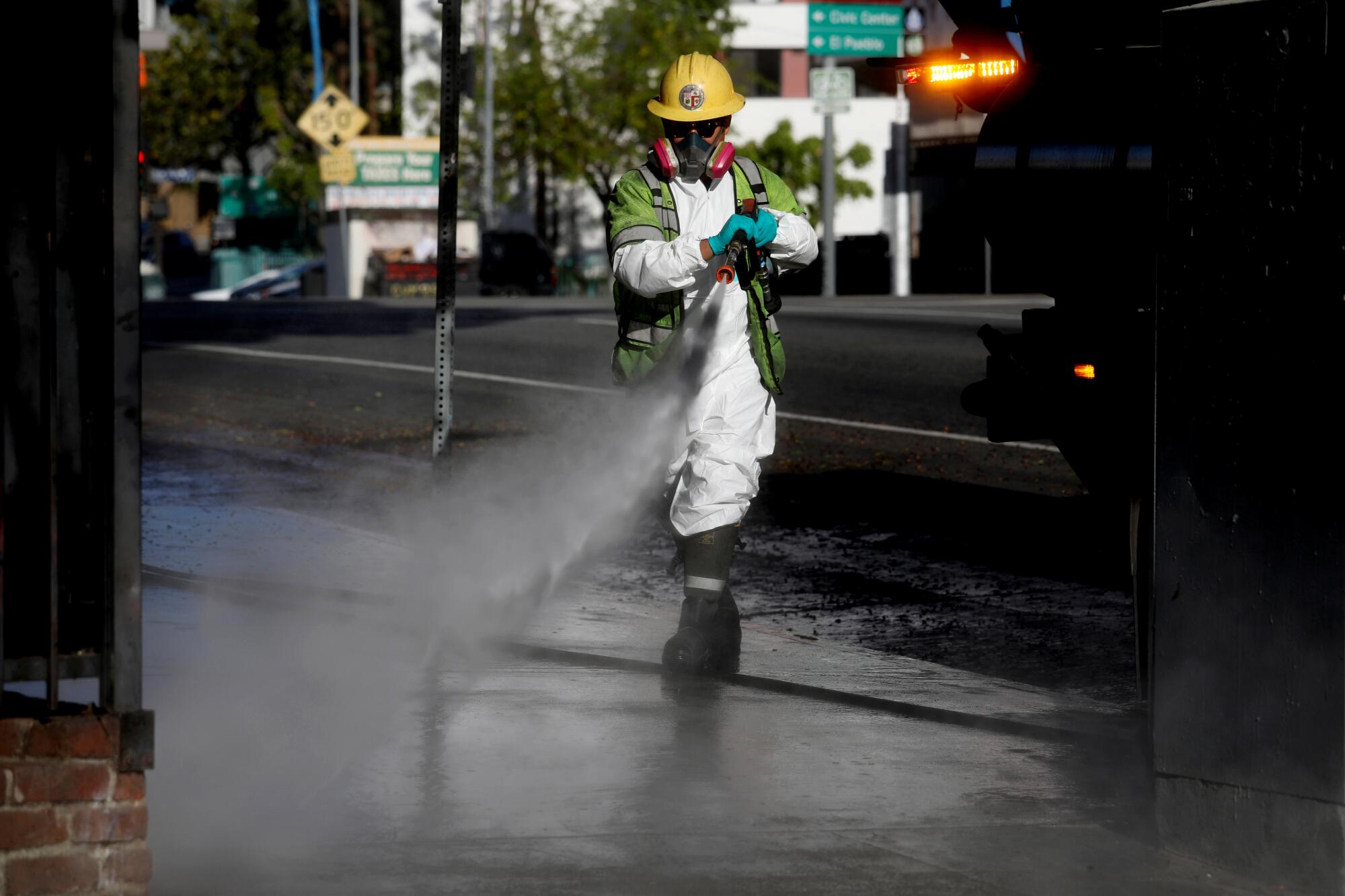
Devereaux said the camps, spreading needles and trash, had prompted two of her neighbors to put their houses up for sale. Many on the street had banded together to email elected officials and local authorities about the fires, thefts and drug dealing.
Still, she was angered that the city couldn’t do more for the people who had lived there. There are still people out there, she said, and they need help.
Councilman Mitch O’Farrell, who represents the area, acknowledged that homeless people can still be found in several of the no-encampment zones in his Hollywood district. But he argued that outreach workers, and his team, are making “real progress,” bringing more people at those locations under a roof.
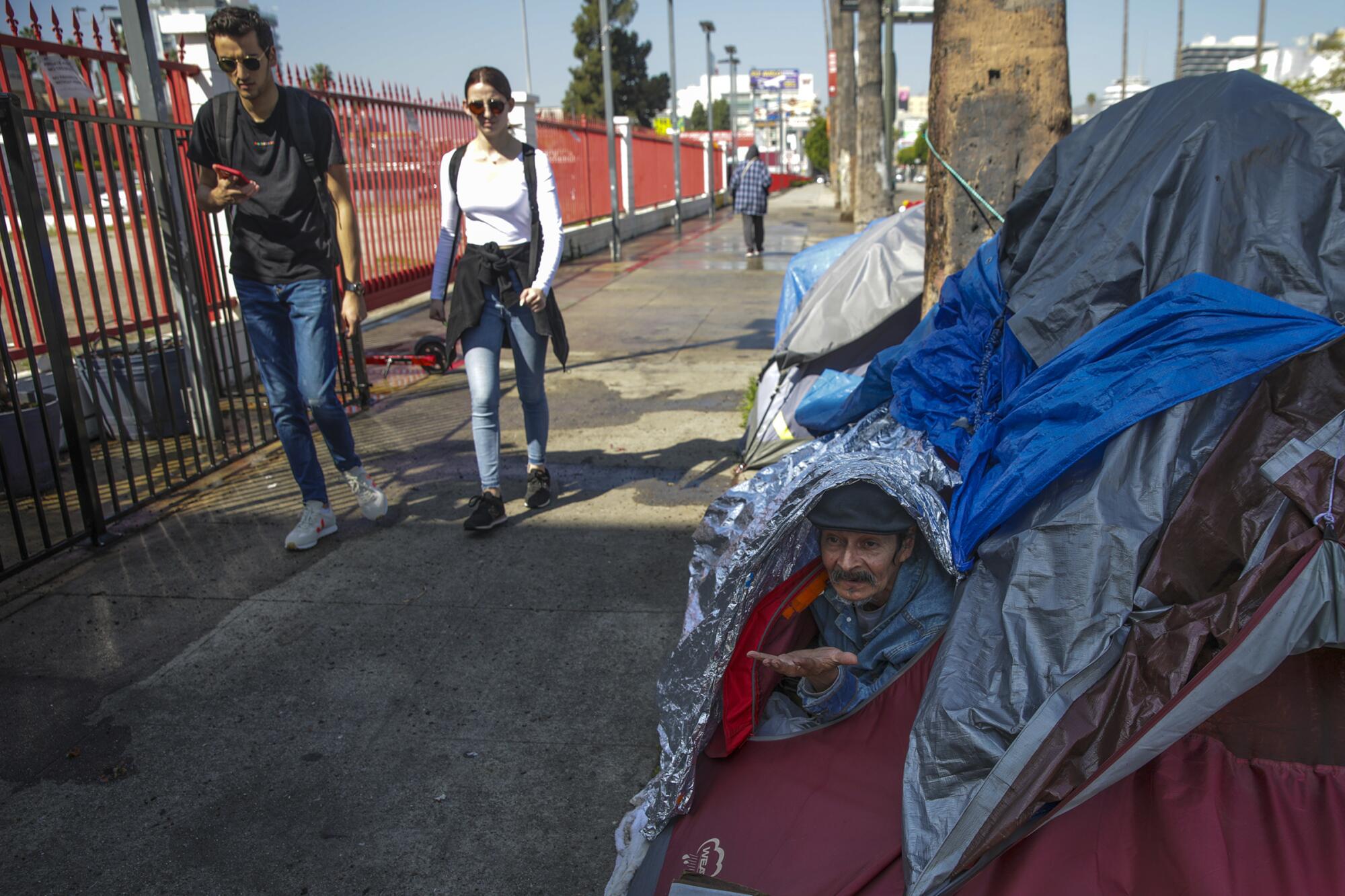
“I don’t think anyone expects us to get out of this within weeks or months. It’s a slog. It’s going to take constant work, and the constant standing up of additional housing solutions.”
Late last week, after The Times reached out to O’Farrell’s office, the encampment on North Vendome Street was cleared. His office didn’t respond to a request for comment when asked where the people living there had gone.
Get the lowdown on L.A. politics
Sign up for our L.A. City Hall newsletter to get weekly insights, scoops and analysis.
You may occasionally receive promotional content from the Los Angeles Times.
Other city officials acknowledge the uneven execution of the new law and cite several causes, including the size of the undertaking, the number of agencies that must coordinate and a limited number of outreach workers and shelter spaces. They said city agencies are learning as they go and adjusting their approach, in some cases giving outreach workers more time to make connections — even if that means postponing enforcement.
The ordinance, adopted by the Los Angeles City Council on a 13-2 vote in July, was designed to bring the city’s existing anti-camping law into compliance with court rulings that prohibit the arrest or ticketing of people sleeping in public if no alternative housing can be provided to them.
Council offices, which take the lead in coordinating the outreach, cleanups by sanitation crews and police response, may have different levels of urgency and different sensibilities about how hard to push.
The revised law prohibits sitting, sleeping or storing items on public property near libraries, parks, day-care centers, schools and other locations. But it also states that enforcement in such places cannot occur until the City Council has reviewed a location and voted to give the go-ahead to clear it.
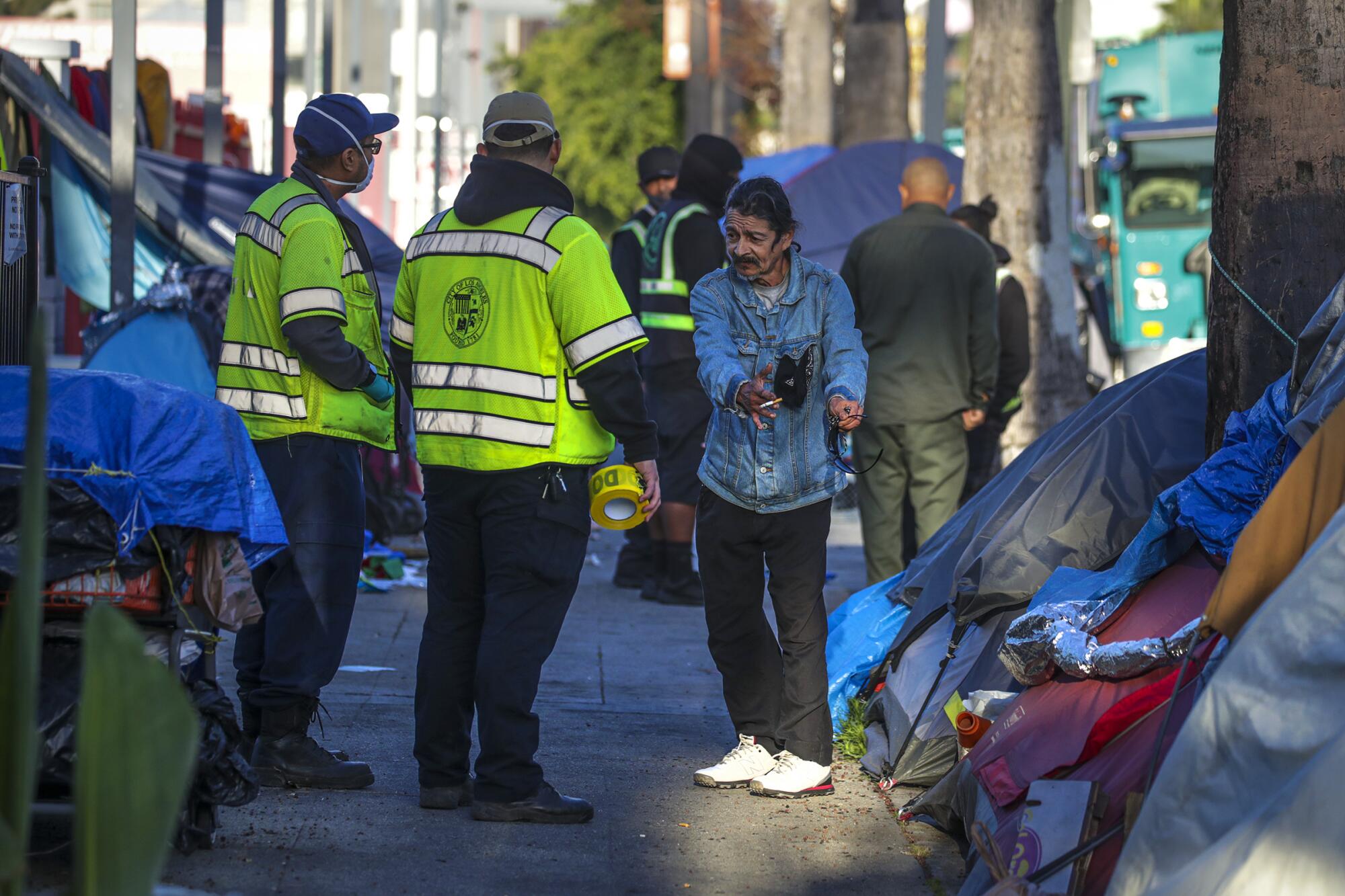
Of the 127 citations issued so far this year under the city’s no camping law, the vast majority — nearly 80% — were for violations that can occur anywhere in the city, such as a tent that is too close to a driveway or blocking sidewalk access for a wheelchair user, said City Administrative Officer Matt Szabo.
Szabo identified only two citations so far this year that were issued for a failure to leave a designated no-encampment zone. The low number, he said, shows the city’s emphasis has been on outreach and getting people into shelters and temporary housing.
“This effort is much more about housing than enforcement,” he said.
Council members promised that any enforcement would follow the arrival of “street engagement teams” — social workers, mental health specialists and others who would offer unhoused people shelter and services.
Still, the city has been slow to build that outreach system. A request for proposals is still being prepared and is not expected to be ready until at least late spring. A separate request for outreach workers to accompany city cleanup crews was canceled when only one bid was received. The request was reissued this month.
In the meantime, the Los Angeles Homeless Services Authority is doing the outreach with teams borrowed from its countywide work.
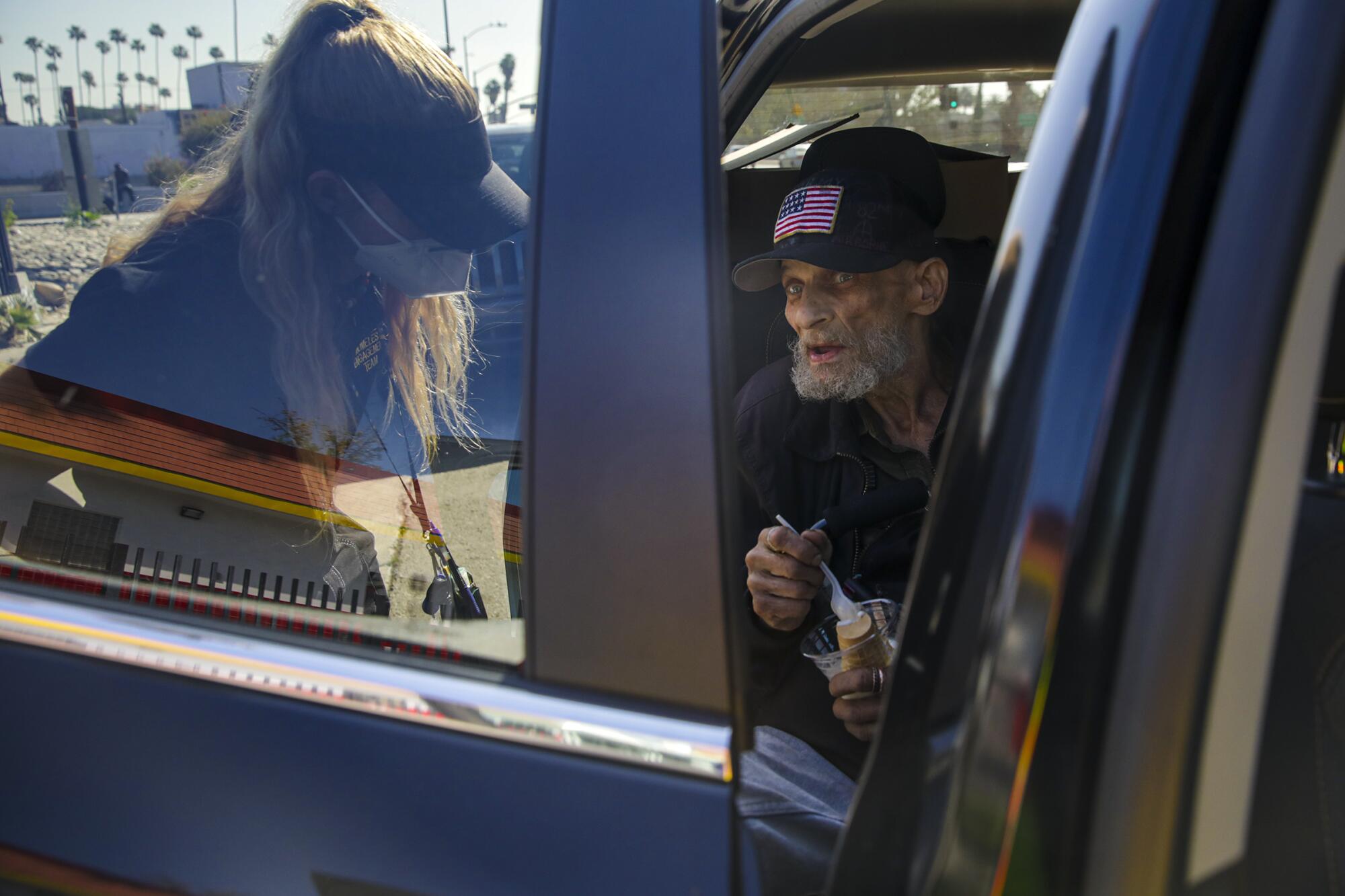
LAHSA executive director Heidi Marston said the agency does two weeks of outreach at each location that is posted, following its “protocol” with the city.
“What happens after that is beyond our scope,” she said. “It’s up to the City Council member.”
Marston, who announced last week that she will resign in May, said the “no camping” deadlines, either already posted or anticipated, impede the work because people often leave the camps, sometimes even before a sign is posted.
“When we have a spot open in a bridge home for Joe Smith, we can’t find Joe Smith anymore, because he left that area,” she said.
All but three of the 15 council members introduced motions that, in total, listed nearly 400 locations — each a buffer zone of 500 or 1,000 feet around either a specific address or length of street — where they wanted to prohibit camping on public right-of-way.
Councilman Joe Buscaino, who is running for mayor on a campaign promise to clean up homeless camps, alone accounted for about half those, identifying 194 locations in his South Bay district. Many of them were schools or parks with no homeless camps.
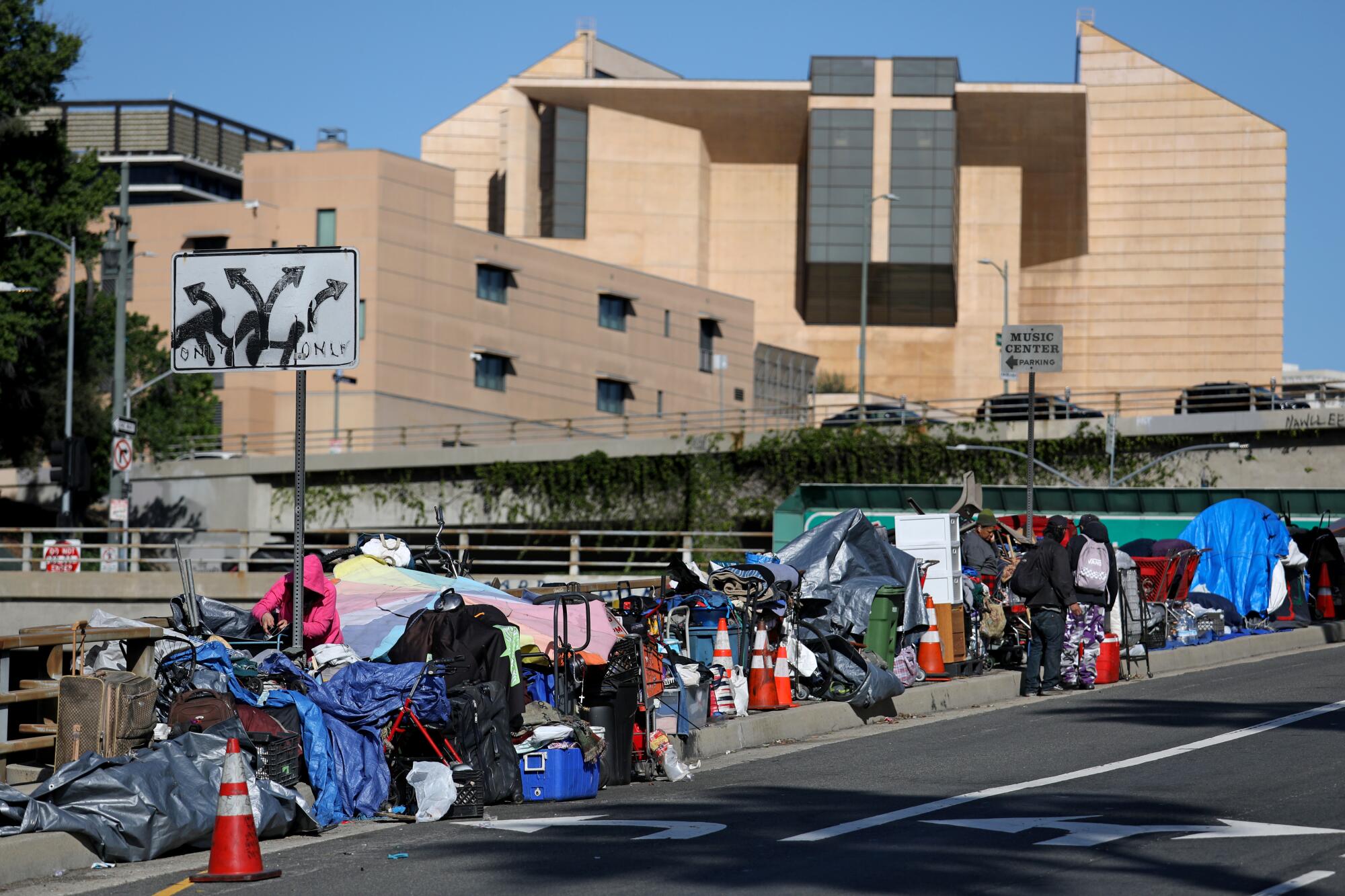
Momentum slowed as the proposals worked their way through the council’s committee process. Installing the signage at a site is expensive; as of early April, it cost $13,000 per location to fabricate and post signs, according to city records. The council rejected almost half of the sites, mostly in Buscaino’s district.
But the Los Angeles Homeless Services Authority started assessing the sites before they were approved and prepared reports on dozens that were ultimately rejected. And, of the approved sites, the agency didn’t complete many of the assessments. In all, LAHSA’s assessments documented 486 people, a tiny fraction of approximately 29,000 people estimated to be living on the city’s streets by the most recent count.
An indication of the messiness of the process: LAHSA found no homeless people at 142 locations that were approved — about 60% of the sites it visited, while reporting significant homeless camps at some of the sites that were dropped.
One such location is the intersection of 253rd Street and Vermont Avenue in Harbor City. The Los Angeles Homeless Services Authority reported 12 people living in front of a church there in October. There were no tents there when The Times visited in April, but half a dozen stretched along 253rd Street next to an apartment and condominium community within what would have been the restricted zone.
At the community’s guard gate, duty officer Anthony Lujano said a cleanup had dislodged the tents to the new spot.
::
Workers began posting signs in early December at some of the 196 sites that were approved, according to city records. By last week, 114 locations had been posted, each having what the city defines as an “enforcement date,” generally about two weeks after the posting.
One councilman who has made evident progress is Kevin de León, who is running for mayor. Outreach workers in his district have succeeded in removing camps from some of the areas now designated as off-limits, including parts of Eagle Rock, El Sereno and downtown.
Last month, a dozen people were relocated from a no-encampment zone on Figueroa Street in Eagle Rock, according to De León spokesman Pete Brown. Ten went into a tiny-home village a block away, he said, while two others moved into a similar village in Highland Park. Those shed-like structures typically offer heating, air conditioning, bathrooms, on-site washer/dryers and come with three meals per day. But they also have strict rules prohibiting guests.
In this area, a citation was issued after a man who had been living on Figueroa repeatedly declined to move into the tiny-home village, complaining of radiation on its grounds. After Los Angeles County’s Department of Mental Health declined to help, Los Angeles police issued a citation and the man left, Brown said.
The work has been more daunting in the downtown portion of De León’s district. His office recently spent two months clearing a two-block stretch of Main Street across from City Hall, moving 127 people into temporary housing, with no citations issued, Brown said.
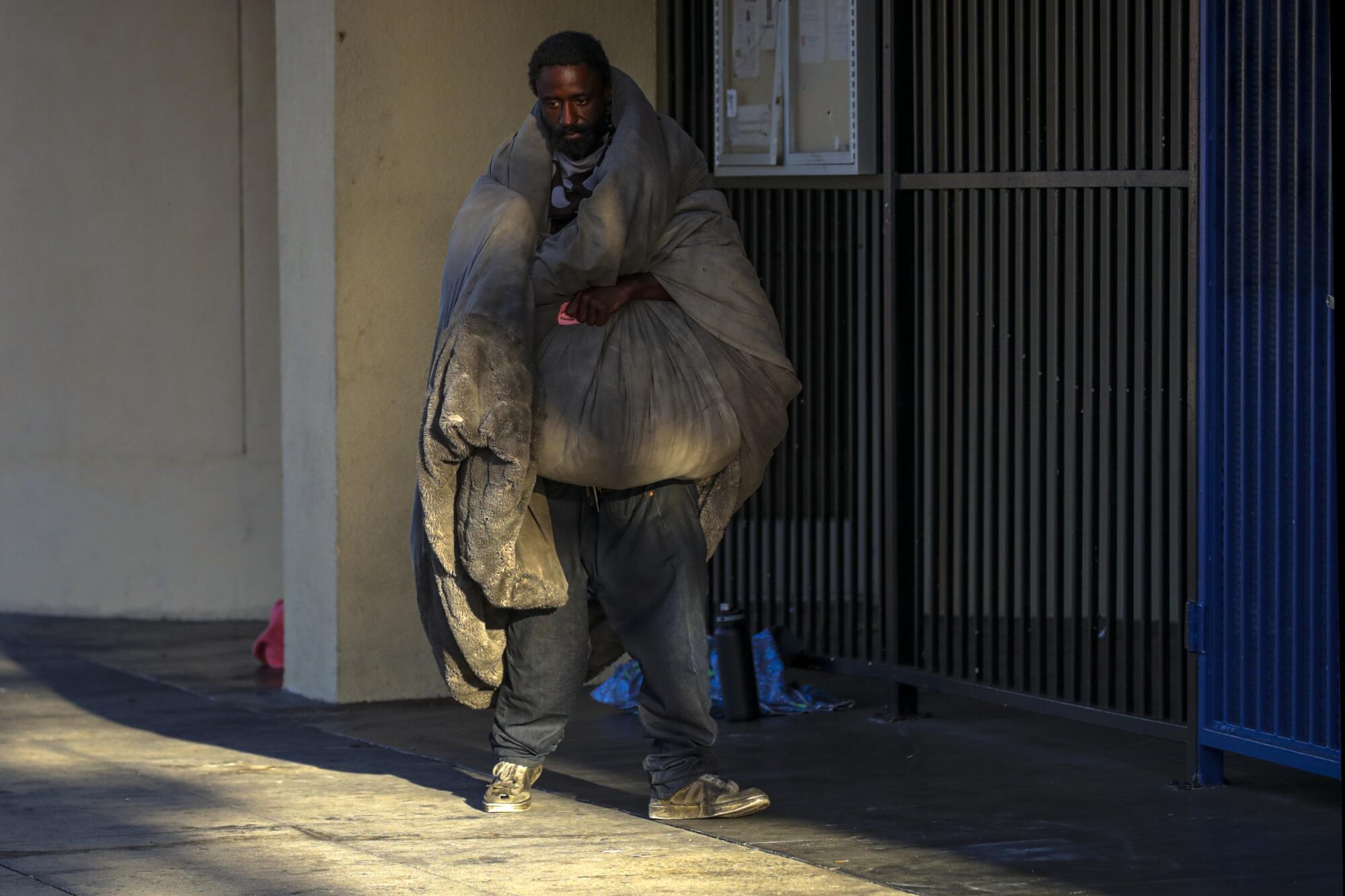
De León said he faces the biggest challenge on the council, since his district has the greatest number of unhoused people. He said his office has focused heavily on the more residential sections of his district — opening shelters and temporary housing in El Sereno, Highland Park and Eagle Rock — and will focus next on Boyle Heights and a larger portion of downtown.
“In the past year, we have housed 80% of unhoused people in northeast Los Angeles,” he said. “By any objective measurement, that’s exceptional progress.”
But two weeks after the April 11 deadline day on Arcadia Street along the 101 Freeway, tents remained. The regular cleanup came as Hernandez anticipated, but he and the other campers were allowed to return their shelters to the sidewalk as before. And in this dreary game of musical chairs, some homeless people are learning the city’s limitations: A new row of tents appeared on a stretch of Cesar Chavez Boulevard that falls just outside several overlapping no-encampment zones.
In other parts of the city, campers have disappeared, but no one knows where they went.
On Sylmar Avenue, just east of the Van Nuys Civic Center, a chain-link fence encloses the arched facade of the Bernardi Multi-Purpose Senior Center — a legacy of a homeless encampment that had occupied the block for years. By mid-April they were gone.
“Praise the heavens above,” said Stephanie Galloway, director of the Bernardi center.
Galloway said she had the fence installed after people sleeping in the building’s arched portico set several fires, littered the area with drug paraphernalia and frightened employees.
A manager at Hamlin Dental Group across the street said staff there had to clean the front porch with Clorox to remove the stench of people sleeping there.
A spokesman for Councilman Paul Krekorian, who represents the east side of the street, said staff from the council office and the Los Angeles Homeless Services Authority persuaded two men to leave the site before the no-camping signs were posted. One is now in permanent housing and one in a shelter.
He said staff at the office did not know about any of the half dozen others who had been counted there.
Nine months after the City Council adopted the new law allowing council members to designate areas as off-limits to homeless camps, permanent metal signs setting deadlines for all homeless people to leave have been posted at more than 100 locations. But tents and makeshift shelters remain at many of the sites even weeks or months past the deadlines as outreach workers struggle to persuade people to move voluntarily and the LAPD has issued tickets sparingly. As of late April, a city official said that 118 citations had been issued across the city.
Similarly, at Westwood Park, in Councilman Paul Koretz’s district, 32 people counted by LAHSA there in October were gone by the end of March.
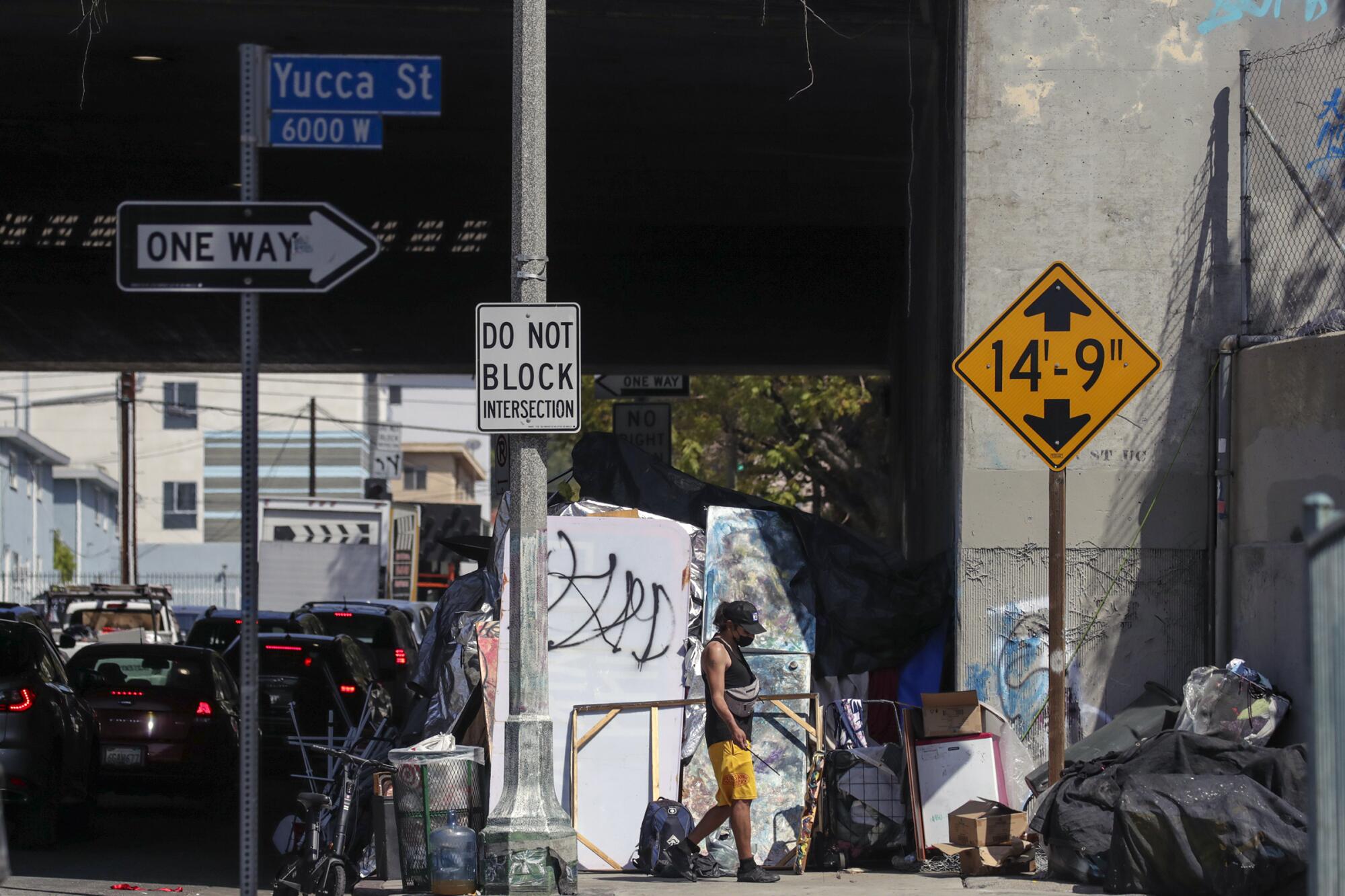
LAHSA spokesman Ahmad Chapman said the agency had offered placements to everyone there either in motels or shelters but he could not say how many had accepted or what happened to those who did not.
In early April, LAHSA outreach workers scored a small success while accompanying a city cleanup crew on a two-block stretch of Hollywood Boulevard at Bronson Avenue — where tents still occupy the sidewalk in a location that had been posted off-limits since Dec. 20.
During that operation, Michael Watson, who has a bad hip and uses a walker, agreed to leave the encampment where he had been living for at least half a year. Sitting in a van awaiting his departure, Watson said he was heading to one of the city’s tiny-home villages.
A day after the cleanup, the area still had more than a dozen tents.
More to Read
Sign up for Essential California
The most important California stories and recommendations in your inbox every morning.
You may occasionally receive promotional content from the Los Angeles Times.
